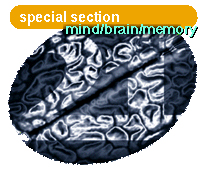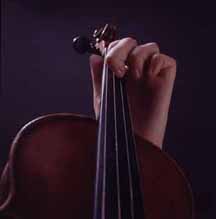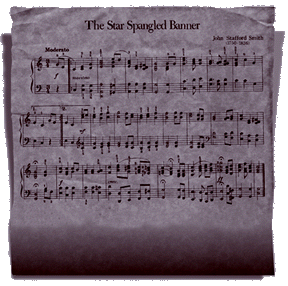

Overtures to a new discipline: neuromusicology
By STEPHEN HART
 PICTURE A
POTENTIAL Paganini, fingers flying up and down the neck of a violin. To sound a high note,
the brain controls shoulder, arm, and finger muscles to aim the left pinky at a particular point
on the string and guide the bow precisely with the right hand and arm. Muscles and joints
provide feedback. Finally, the feel of the string and the perception of sound signal success to
the brain. Music being one of humankind's most complex activities, the study of how the
brain produces and comprehends it runs the gamut from neuroscience to philosophy. The
specialty of musicology is now augmented by the findings of laboratory and clinical scientists.
PICTURE A
POTENTIAL Paganini, fingers flying up and down the neck of a violin. To sound a high note,
the brain controls shoulder, arm, and finger muscles to aim the left pinky at a particular point
on the string and guide the bow precisely with the right hand and arm. Muscles and joints
provide feedback. Finally, the feel of the string and the perception of sound signal success to
the brain. Music being one of humankind's most complex activities, the study of how the
brain produces and comprehends it runs the gamut from neuroscience to philosophy. The
specialty of musicology is now augmented by the findings of laboratory and clinical scientists.
While monitoring all the muscles involved in performance would be infeasible in the laboratory, Edward Taub, a behavioral neuroscientist at the University of Alabama, Birmingham, and Thomas Elbert of the University of Konstanz, Germany, measured the response of musicians' brains to touch. Taub and colleagues combined magnetoencephalographic measurements of the minute magnetic field produced by electrical activity of brain cells with magnetic resonance imaging to precisely locate cells responding to a gentle touch on the left pinky. In the first work of its kind in humans, Taub showed more brain cells responding to musicians' agile left pinkies than to the left thumb, which supports the instrument, or to right-hand digits, which hold the bow. Brain maps of the digits of non-musicians differed little from pinky to thumb, from right to left, or from the right digits of musicians. Practice, Taub concludes, remaps the brain.
Taub was not surprised to find that the earlier in life a musician begins serious practice, the greater the remapping. But late starters provided a surprise. Although beginning after the age of 12 predicted less brain change, adult brains did change in response to practice. This finding flies in the face of neurologic dogma that adult brains no longer develop. "The fact is that there is still a potential for plasticity after the age of 13," Taub says. He conjectures that brain areas controlling muscles also enlarge with practice.
Even years of practice can go awry when a musician's well-trained muscles begin to refuse orders, twitching fingers off strings. This malady--focal dystonia, often misleadingly called musician's cramp--puzzles neurologists such as Richard Lederman, director of the Cleveland Clinic's Medical Center for Performing Artists. "These are disorders that very much involve the brain," he says. "People who wrote about this kind of disorder 100 years ago emphasized that the entire pathway is required, from the sensing of input in the fingertips all the way up to the brain and back out to the muscles."
Neurologists have yet to pinpoint a cause for dystonias or a faulty area in the brain. Treatment, too, lags. Minute injections of botulinum toxin--from the bacteria that spoil canned food--can weaken muscles and relieve the sudden finger twitching, an imperfect solution. Lederman hopes that growing interest in the neurologic problems of musicians, combined with new non-invasive brain imaging and monitoring techniques, will lead to new help for performers.
Performance provides only half the experience of music; listening is just as dependent on brain functions. Diana Deutsch, professor of psychology at the University of California, San Diego, has created a number of musical illusions, which seem to show a discrepancy between what's played and what's perceived. Take, for example, the octave illusion: a two-note pattern presented to both ears appears to leap from right to left, the high note in one ear and the low note in the other. Switch the earphones and the high note surprisingly seems to remain in the same ear. Even stranger, right-handers tend to hear the high note in the right ear; left-handers vary. Although the brain produces these musical paradoxes, researchers have no current candidates for a location or mechanism.(1)
Even if the brain can be fooled, music can trigger powerful emotions. And instrumental or vocal performance demands almost unbelievable dexterity. Why? How did music evolve? "Nobody knows why we have music in the first place," says Columbia's John C.M. Brust, P&S professor of clinical neurology at Harlem Hospital Center. Language makes a compelling candidate as a forerunner of music; all cultures have language, and the leap from emotion-laden language to singing to instrumental music seems logical. But Brust also points out distinct differences. "Everybody who's normal possesses language," he says. "By contrast, the spectrum of musical ability runs from perfect pitch to tone-deafness, regardless of general intelligence."
Columbia philosopher Mark A. DeBellis approaches neuromusicology from a different level. "Does somebody who knows [music] theory hear the same thing as somebody who doesn't know the theory?" he asks. Some theoreticians suggest that listeners unconsciously use concepts such as cadence, tonic, and dominant. DeBellis responds: "To rely on conscious vs. unconscious is to explain the obscure by the more obscure. For most listeners, musical concepts aren't integrated with their hearing the way they are for analysts and theorists."
 DeBellis
contrasts place perception to pitch perception. Shown a picture or written description, most
people could recognize and reidentify a place, but many listeners can't do the same with notes.
"In the 'Star-Spangled Banner''s 'Oh say can you see by the dawn's early light,' the first
pitch turns out to be the same as the last pitch," DeBellis says, "but a lot of
listeners aren't able to tell you that. In my view, that means that although people perceive
pitch, it's not conceptualized." DeBellis has laid out this framework of music listening in
his recently published Music and Conceptualization (Cambridge University
Press, 1995).(2)
DeBellis
contrasts place perception to pitch perception. Shown a picture or written description, most
people could recognize and reidentify a place, but many listeners can't do the same with notes.
"In the 'Star-Spangled Banner''s 'Oh say can you see by the dawn's early light,' the first
pitch turns out to be the same as the last pitch," DeBellis says, "but a lot of
listeners aren't able to tell you that. In my view, that means that although people perceive
pitch, it's not conceptualized." DeBellis has laid out this framework of music listening in
his recently published Music and Conceptualization (Cambridge University
Press, 1995).(2)
"I think there's a basis in the brain for all of this," DeBellis concludes. "There are different levels of description for what the brain is doing. There's the mentalistic level of description, where we talk about beliefs and desires and conceptual vs. non-conceptual representation, and then there's the neurological level of description. Our view of how these levels relate to one another will depend on our perspectives in both philosophy and neurology. In terms of understanding how the mind works, we're approaching the problem on both levels."
NEUROLOGIST JOHN C.M. Brust, an opera lover who also calls himself "a mostly
retired jazz saxophonist," became interested in the neurology of music because of two
patients with brain damage. The first suffered a tumor and seizure, losing her ability to speak
(a condition called aphasia), but she could still sing. "When she sang," Brust says,
"she sang, not perfectly, but almost perfectly, the correct words." The second, a
jazz bassist, had a stroke and lost his ability to read and write music and to identify and
reproduce tone intervals (amusia).
"If you then use patients like this as a jumping off point, you find that there is a huge
literature going back into the 19th century: one report after another of a very peculiar type of
musical abnormality." Some hear music in a distorted fashion, others suddenly cannot
sing in key, and still others lose their ability to respond emotionally to music. Brust cites a
case of a conductor who lost both his emotional responses to music and his ability to compose
emotionally stirring music. (He retained the ability to write 12-tone music--though he still
didn't like it.)
Neurologist Oliver Sacks, in An Anthropologist on Mars (Knopf, 1995), writes
about a young man who had an orange-sized brain tumor that robbed him of his eyesight, his
spontaneity, and much of his memory. Sacks reports, however, that a discussion of the man's
favorite group, the Grateful
Dead, seemed to snap him back into reality. He not only remembered musical details
but became animated and articulate, listing band members, concert dates, and songs.
Researchers have learned much about language and the brain from studying cases of brain
damage. That hasn't happened to date with music, perhaps because the concatenation of
specific brain damage and great musical ability is so rare. In contrast to language, Brust muses,
a clearly demarcated cerebral localization for music processing is unlikely. "Music is
simply not the summation of its different components--of loudness, of melody, of timbre. It is
a far more complex psychological whole."
PHOTO &
ART CREDITS: Jonathan Smith (1); Howard Roberts (2).
Deutsch has recorded a compact disk of
musical illusions, Musical Illusions and Paradoxes (Philomel, 1995), which comes with an
explanatory booklet. See also Deutsch, Diana, "Paradoxes of Musical Pitch,"
Scientific American 267:288-95 (August 1992). For more information, contact
Deutsch at P.O. Box 12189, La Jolla, CA 92039-2189, on the Philomel Records homepage, or by e-mail.
When the notes fall silent
STEPHEN HART has written about
biology, medicine, technology, and earth science for Discover, Patient
Care, The Scientist, BioScience, and other publications; he
is the author of The Language of Animals (Henry Holt, 1996).




